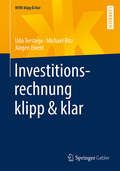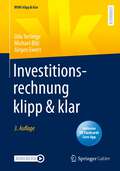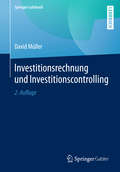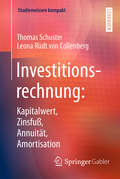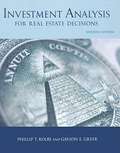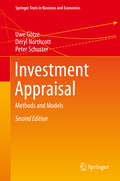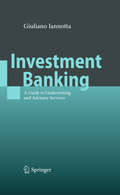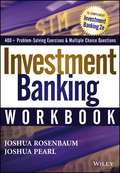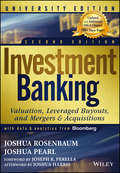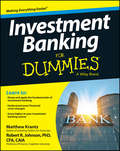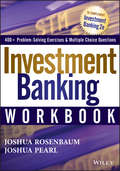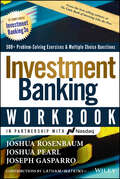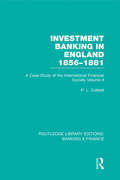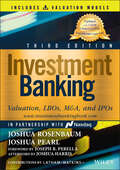- Table View
- List View
Investitionsrechnung für Praktiker: Fallorientierte Darstellung der Verfahren und Berechnungen
by Bernd Heesen Michelle Julia HeesenDas Werk stellt die klassischen Fragen der Investitionsrechnung an einem Excel-basierten mehrperiodischen Beispiel-Unternehmen im Detail dar. Während die für die Praxis weniger relevanten statischen Ansätze nur kurz dargestellt werden, liegt der Schwerpunkt auf den dynamischen Ansätzen und daraus abzuleitenden Kennzahlen für die detaillierte Analyse aus verschiedenen Blickwinkeln. Das Buch richtet sich an Praktiker, die Investitionen und ih unter Contracts/Rightsre Finanzierung planen, begleiten und überprüfen sowie an Studierende, die ein praktisches Verständnis betriebswirtschaftlicher Zusammenhänge erlangen möchten.
Investitionsrechnung klipp & klar (WiWi klipp & klar)
by Michael Bitz Udo Terstege Jürgen EwertIm Zentrum des Buches stehen Verfahren, die Investitionsentscheidungen auf der Basis finanzmathematischer Kennzahlen erlauben sollen. Zunächst werden die modelltheoretischen und finanzmathematischen Grundlagen der Kennzahlen und ihrer Verwendung vermittelt. Auf dieser Basis werden anschließend die wichtigsten Kennzahlen vorgestellt, ihre Berechnung verdeutlicht und ihre Eignung zur Ableitung „vernünftiger“ Investitionsentscheidungen analysiert. Während die Betrachtungen zunächst auf eine stark idealisierte Modellwelt beschränkt bleiben, wird abschließend verdeutlicht, wie davon abweichende reale Gegebenheiten, insbes. Steuern und Unsicherheit, in die Betrachtungen integriert werden können.Alle Überlegungen setzen nahezu kein Vorwissen voraus, gehen in kleinen Schritten vor und sind durch zahlreiche Beispiele und Übungen unterlegt. Dadurch ist das Buch vor allem für Themenneulinge, insbes. Studierende in einem Bachelorstudiengang, und für ein Selbststudium geeignet.
Investitionsrechnung klipp & klar (WiWi klipp & klar)
by Michael Bitz Udo Terstege Jürgen EwertIm Zentrum des Buches stehen Verfahren, die Investitionsentscheidungen auf der Basis finanzmathematischer Kennzahlen erlauben sollen. Zunächst werden die modelltheoretischen und finanzmathematischen Grundlagen der Kennzahlen und ihrer Verwendung vermittelt. Auf dieser Basis werden anschließend die wichtigsten Kennzahlen vorgestellt, ihre Berechnung verdeutlicht und ihre Eignung zur Ableitung „vernünftiger“ Investitionsentscheidungen analysiert. Während die Betrachtungen zunächst auf eine stark idealisierte Modellwelt beschränkt bleiben, wird abschließend verdeutlicht, wie davon abweichende reale Gegebenheiten, insbes. Steuern und Unsicherheit, in die Betrachtungen integriert werden können.Alle Überlegungen setzen nahezu kein Vorwissen voraus, gehen in kleinen Schritten vor und sind durch zahlreiche Beispiele und Übungen unterlegt. Dadurch ist das Buch vor allem für Themenneulinge, insbes. Studierende in einem Bachelorstudiengang, und für ein Selbststudium geeignet.
Investitionsrechnung klipp & klar (WiWi klipp & klar)
by Michael Bitz Udo Terstege Jürgen EwertIm Zentrum des Buches stehen Verfahren, die Investitionsentscheidungen auf der Basis finanzmathematischer Kennzahlen erlauben sollen. Zunächst werden die modelltheoretischen und finanzmathematischen Grundlagen der Kennzahlen und ihrer Verwendung vermittelt. Auf dieser Basis werden anschließend die wichtigsten Kennzahlen vorgestellt, ihre Berechnung verdeutlicht und ihre Eignung zur Ableitung „vernünftiger“ Investitionsentscheidungen analysiert. Während die Betrachtungen zunächst auf eine stark idealisierte Modellwelt beschränkt bleiben, wird abschließend verdeutlicht, wie davon abweichende reale Gegebenheiten, insbes. Steuern und Unsicherheit, in die Betrachtungen integriert werden können.Alle Überlegungen setzen nahezu kein Vorwissen voraus, gehen in kleinen Schritten vor und sind durch zahlreiche Beispiele und Übungen unterlegt. Dadurch ist das Buch vor allem für Themenneulinge, insbes. Studierende in einem Bachelorstudiengang, und für ein Selbststudium geeignet.Zusätzliche Fragen per App: Laden Sie die Springer Nature Flashcards-App kostenlos herunter und nutzen Sie exklusives Zusatzmaterial, um Ihr Wissen zu prüfen.
Investitionsrechnung und Investitionscontrolling (Springer-Lehrbuch)
by David MüllerInvestitionen als eine wesentliche Grundlage unternehmerischer Tätigkeit sind durch komplexe Entscheidungsprozesse gekennzeichnet. Zentrale Aufgabe des Investitionscontrollings ist deshalb die Unterstützung der Planung, Realisierung und Umsetzung dieser Entscheidungen.Damit diese Aufgabe bestmöglich erfüllt werden kann, wurde die vorliegende Auflage neu strukturiert. Die Eigenschaften des Investitionsprozesses und des Investitionscontrollings werden in den ersten beiden Kapiteln vorgestellt. Im Anschluss daran werden die Grundlagen der Entscheidungstheorie dargelegt. Diese werden üblicherweise als Einzelentscheidungen betrachtet, jedoch sind Investitionsentscheidungen in den seltensten Fällen Individualentscheidungen. In der Regel sind mehrere Mitarbeiter und Abteilungen in die Entscheidungsprozesse eingebunden. Es liegt nahe, neben den Individualentscheidungen auch kollektive Entscheidungen zu berücksichtigen. Aus diesem Grund werden Theorie und Praxis kollektiver Entscheidungen in einem eigenständigen Kapitel beleuchtet.Neben der Entscheidungstheorie bildet die Investitionstheorie das klassische Fundament zur Unterstützung von Investitionsentscheidungen. Die grundlegenden Verfahren für Situationen unter Sicherheit werden ebenso vorgestellt wie die Verfahren für Entscheidungen unter Unsicherheit.Eine ganze Reihe von Investitionen wird nicht durch einen einzelnen Akteur (z.B. Unternehmen, Kostenstelle, Gemeinde) sondern als Gemeinschaftsinvestitionen durch mehrere Akteure realisiert. Die kooperative Spieltheorie ist in der Lage, für eine gerechte Nutzenaufteilung zu sorgen. Deshalb ist diesem Bereich ein umfangreiches Kapitel mit vielen Anwendungsbeispielen gewidmet.
Investitionsrechnung: Grundlagen – Aufgaben – Lösungen
by Kay PoggenseeDieses fundierte Lehrbuch führt in das klassische Themenspektrum der Investitionsrechnung ein. Ein wichtiges didaktisches Element ist die ausführliche Darstellung von Rechenbeispielen mit Musterlösungen, die auch Excel-basiert bearbeitet werden können.Der Autor analysiert die Modelle aus einer kritischen Grundhaltung heraus und ermöglicht dadurch eine eigene Bewertung. „Investitionsrechnung“ eignet sich für die theoretische und anwendungsbezogene Ausbildung auf allen Niveaustufen. In der 3. Auflage wurden insbesondere in Kapitel 4 Ergänzungen vorgenommen. Konkret ist der Bereich zur Kontoentwicklung und insbesondere zur Linearen Optimierung deutlich ausgebaut worden. Außerdem ist das einführende Kapitel 1 aufgrund der Weiterentwicklung der Wirtschaftstätigkeit in der Praxis in den vergangenen Jahren an die Entwicklungen in der Wirtschaft angepasst worden.
Investitionsrechnung: Kapitalwert, Zinsfuß, Annuität, Amortisation
by Thomas Schuster Leona Rüdt von CollenbergDieses Lehrbuch behandelt die Grundlagen der Investitionsrechnung. Es vermittelt die einschlägigen Fachbegriffe im Gebiet der Investitionstheorie und macht mit den wichtigsten Modellen der Investitionsrechnung vertraut. Es werden die Kapitalwertmethode, die interne Zinsfußmethode, die Annuitätenmethode und die dynamische Amortisationsdauermethode dargestellt. Ein Kapitel über die Bestimmung des Kalkulationszinssatzes rundet den Inhalt ab. Das Buch gibt Hinweise für die korrekte Auswahl eines Investitionsrechenverfahrens unter Berücksichtigung der betrieblichen Gegebenheiten. Die Leser erhalten anhand von zahlreichen Beispielen einen Einblick in die angewandten Verfahren der Investitionsrechnung in der Unternehmenspraxis.Kurze Lerneinheiten, übersichtliche didaktische Module sowie die begleitende Lernkontrolle sorgen für eine nachhaltige Wissensvermittlung. Das Buch richtet sich damit an alle, die sich mit Fragen der Investitionsrechnung im Rahmen ihrer Aus- und Weiterbildung (auch im Nebenfach) sowie ihrer beruflichen Praxis auseinandersetzen.
Investitori Associati: Exiting the Savio LBO (A)
by Josh Lerner Giampiero Mazza Dino CattaneoInvestitori Associati seeks to exit a leveraged buyout investment. Choosing the appropriate way in which to undertake their exit-an initial public offering or sale of the firm-proves problematic.
Investment Analysis and Lockheed Tri Star
by Michael E. EdlesonA set of five exercises in capital budgeting. Student calculates and compares various decision criteria (including IRR and NPV) for capital investment projects. This is an introductory case, where relevant cash flows are provided, and the focus is on the discounting mechanics and the decision to invest. In addition, one exercise directly probes the link between positive NPV projects, and value added to the shareholders. The final "exercise" is a three page mini-case analyzing Lockheed's decision to invest in the TriStar L-1011 Airbus project. This drives home the importance of discounting and NPV, and shows the adverse effect of a negative NPV project on shareholder value.
Investment Analysis for Real Estate Decisions (7th edition)
by Phillip T. Kolbe Gaylon E. GreerThe three most important things in real estate are still location, location, location, but the industry is going through many transformations.
Investment Analysis: An Introduction to Portfolio Theory and Management
by Mike DempseyThis textbook is designed as a core text for finance courses that cover market investments, portfolio formation, and the management of investment portfolios. As such, the text seeks to convey insight and actual wisdom as to the nature of these activities. When combined with a commitment to thinking independently, the text offers the student a rigorous preparation for entry to the funds management industry. The text is presented in three parts. In Part A, the text introduces the fundamental techniques of investment analysis: a "bottom-up" and "top-down" analysis of the firm aimed at an evaluation of the underlying share as a "buy", "hold", or a "sell" recommendation. Part B offers the reader an intuitive grasp of the nature of investment growth, both across time and across assets. Part C introduces the reader to the technicalities of portfolio construction and portfolio management. The text concludes with an assessment of the funds management industry. The text builds in step-by-step stages with Illustrative Examples that consolidate the student’s progress and understanding through each chapter. Each of parts A, B, and C (above) has sufficient material to justify a separate course. If the student has exposure to a more foundational course in finance, Parts A and B can be covered as a single course. If from other courses, the student is familiar with the essence of Parts A and B and with statistical concepts, the text can be covered as a single course. The text can therefore be presented readily at either an undergraduate or postgraduate level at a pace appropriate to the student’s prior exposure to the concepts.
Investment Appraisal
by Uwe Götze Peter Schuster Deryl NorthcottThis book provides an introduction to investment appraisal and presents a range of methods and models, some of which are not widely known, or at least not well covered by other textbooks. Each approach is thoroughly described, evaluated and illustrated using examples, with its assumptions and limitations analyzed in terms of their implications for investment decision-making practice. Investment decisions are of vital importance to all companies. Getting these decisions right is crucial but, due to a complex and dynamic business environment, this remains a challenging management task. Effective appraisal methods are valuable tools in supporting investment decision-making. As organisations continue to seek a competitive edge, it is increasingly important that management accountants and strategic decision-makers have a sound knowledge of these tools.
Investment Banking
by Giuliano IannottaThe recent financial turmoil has raised suspects on investment banks and will certainly reshape the industry. However, the transactions traditionally managed by investment banks will still require the intervention of financial institutions, as always in the past. This book aims at providing an overview of these traditional investment banking activities. It covers the main areas of investment banking: security underwriting (equity and debt), syndicated loans, market for corporate control (M&As, LBOs, etc.), restructuring. There is an impressive amount of research papers on the different areas of investment banking. While this growing literature provides a conceptual framework, it has little to say on "how to do things". The aim of the book is to blend the scholars' and practitioners' views: every transaction is examined from both perspectives. Even when deeper attention is given to research, it is done with the simple and effective language of business.
Investment Banking
by Joseph R. Perella Joshua Pearl Joshua RosenbaumIn the constantly evolving world of finance, a solid technical foundation is an essential tool for success. Due to the fast-paced nature of this world, however, no one has been able to take the time to properly codify the lifeblood of the corporate financier's work--namely, valuation. Rosenbaum and Pearl have responded to this need by writing the book that they wish had existed when they were trying to break into Wall Street. Investment Banking: Valuation, Leveraged Buyouts, and Mergers & Acquisitions is a highly accessible and authoritative book that focuses on the primary valuation methodologies currently used on Wall Street--comparable companies, precedent transactions, DCF, and LBO analysis. These methodologies are used to determine valuation for public and private companies within the context of M&A transactions, LBOs, IPOs, restructurings, and investment decisions. Using a step-by-step how-to approach for each methodology, the authors build a chronological knowledge base and define key terms, financial concepts, and processes throughout the book. They also provide a comprehensive overview of the fundamentals of LBOs and an organized M&A sale process. In the aftermath of the subprime mortgage crisis and ensuing credit crunch, the world of finance is returning to the fundamentals of valuation and critical due diligence. This involves the use of more realistic assumptions governing approach to risk as well as a wide range of value drivers. While valuation has always involved a great deal of "art" in addition to time-tested "science," the artistry is perpetually evolving in accordance with market developments and conditions. In this sense, this book is particularly topical--in addition to detailing the technical fundamentals behind valuation, the authors infuse practical judgment skills and perspective to help guide the science.
Investment Banking
by Joshua Pearl Joshua RosenbaumInvestment Banking, UNIVERSITY EDITION is a highly accessible and authoritative book written by investment bankers that explains how to perform the valuation work at the core of the financial world. This body of work builds on Rosenbaum and Pearl's combined 30+ years of experience on a multitude of transactions, as well as input received from numerous investment bankers, investment professionals at private equity firms and hedge funds, attorneys, corporate executives, peer authors, and university professors.This book fills a noticeable gap in contemporary finance literature, which tends to focus on theory rather than practical application. It focuses on the primary valuation methodologies currently used on Wall Street--comparable companies, precedent transactions, DCF, and LBO analysis--as well as M&A analysis. The ability to perform these methodologies is especially critical for those students aspiring to gain full-time positions at investment banks, private equity firms, or hedge funds. This is the book Rosenbaum and Pearl wish had existed when we were trying to break into Wall Street.Written to reflect today's dynamic market conditions, Investment Banking, UNIVERSITY EDITION skillfully: Introduces students to the primary valuation methodologies currently used on Wall StreetUses a step-by-step how-to approach for each methodology and builds a chronological knowledge baseDefines key terms, financial concepts, and processes throughoutProvides a comprehensive overview of the fundamentals of LBOs and an organized M&A sale processPresents new coverage of M&A buy-side analytical tools--which includes both qualitative aspects, such as buyer motivations and strategies, along with technical financial and valuation assessment toolsIncludes a comprehensive merger consequences analysis, including accretion/(dilution) and balance sheet effectsContains challenging end-of-chapter questions to reinforce concepts covered A perfect guide for those seeking to learn the fundamentals of valuation, M&A , and corporate finance used in investment banking and professional investing, this UNIVERSITY EDITION--which includes an instructor's companion site--is an essential asset. It provides students with an invaluable education as well as a much-needed edge for gaining entry to the ultra-competitive world of professional finance.
Investment Banking Focus Notes: Focus Notes (Wiley Finance)
by Joshua Pearl Joshua RosenbaumInvestment Banking FOCUS NOTES provides a comprehensive, yet streamlined, review of the basic skills and concepts discussed in Investment Banking: Valuation, Leveraged Buyouts, and Mergers & Acquisitions, Second Edition. The focus notes are designed for use both as a companion to the book, as well as on a standalone basis. Investment Banking focuses on the primary valuation methodologies currently used on Wall Street—namely, comparable companies analysis, precedent transactions analysis, DCF analysis, and LBO analysis—as well as detailed M&A analysis from both a sell-side and buy-side perspective. Our focus notes seek to help solidify knowledge of these core financial topics as true mastery must be tested, honed, and retested over time.
Investment Banking For Dummies
by Robert R. Johnson Matthew KrantzEnrich your career with a review of investment banking basicsOne of the most lucrative fields in business, investment banking frequently perplexes even banking professionals working within its complex laws. Investment Banking For Dummies remedies common misconceptions with a straightforward assessment of banking fundamentals. Written by experts in stock market proceedings, this book runs parallel to an introductory course in investment banking. It clearly outlines strategies for risk management, key investment banking operations, the latest information on competition and government regulations, and relationships between leveraged buyout funds, hedge funds, and corporate and institutional clients. With this reference, you can ace investment banking courses and grasp the radical changes that have revamped the stock market since the financial crisis.Thoroughly addresses the dramatic financial changes that have occurred in recent yearsOutlines expectations to prepare you for the futureTeaches the practical aspects of finance and investment banking, how to value a company, and how to construct a financial modelNo serious business student or banking professional should be without the basic knowledge of issuing bonds, stocks, and other financial products outlined in this excellent resource.
Investment Banking For Dummies
by Robert R. Johnson Matthew KrantzGet started in investment banking Ace your investment bank course Navigate bull and bear markets Excel in the world of investment banking One of the most lucrative fields in business, investment banking frequently perplexes even banking professionals working within its complex laws. Investment Banking For Dummies remedies common misconceptions with a straightforward assessment of banking fundamentals. This book tracks to typical university courses on the subject and helps students and professionals understand the fundamentals of investment banking. With new and updated content, this edition addresses the major financial changes that have occurred in recent years. Inside... Key investment banking operations Strategies for risk management Advice on cryptocurrencies Updated IPO coverage Discounted cash flow analysis Mergers and acquisitions Structuring a leveraged buyout Resources for investment bankers
Investment Banking For Dummies
by Robert R. Johnson Matthew KrantzGet started in investment banking Ace your investment bank course Navigate bull and bear markets Excel in the world of investment banking One of the most lucrative fields in business, investment banking frequently perplexes even banking professionals working within its complex laws. Investment Banking For Dummies remedies common misconceptions with a straightforward assessment of banking fundamentals. This book tracks to typical university courses on the subject and helps students and professionals understand the fundamentals of investment banking. With new and updated content, this edition addresses the major financial changes that have occurred in recent years. Inside... Key investment banking operations Strategies for risk management Advice on cryptocurrencies Updated IPO coverage Discounted cash flow analysis Mergers and acquisitions Structuring a leveraged buyout Resources for investment bankers
Investment Banking Workbook (Wiley Finance)
by Joshua Pearl Joshua RosenbaumInvestment Banking WORKBOOK is the ideal complement to Investment Banking, Valuation, Leveraged Buyouts, and Mergers & Acquisitions, Second Edition, enabling you to truly master and refine the core skills at the center of the world of finance. This comprehensive study guide provides an invaluable opportunity to explore your understanding of the strategies and techniques covered in the main text, before putting them to work in real-world situations. The WORKBOOK—which parallels the main book chapter by chapter—contains over 400 problem-solving exercises and multiple-choice questions. Topics reviewed include: Valuation and its various forms of analysis, including comparable companies, precedent transactions and discounted cash flow analysis Leveraged buyouts—from the fundamentals of LBO economics and structure to detailed modeling and valuation M&A sell-side tools and techniques, including an overview of an organized M&A sale process M&A buy-side strategy and analysis, including a comprehensive merger consequences analysis that includes accretion/(dilution) and balance sheet effects The lessons found within will help you successfully navigate the dynamic world of investment banking and professional investing. Investment Banking WORKBOOK will enable you to take your learning to the next level in terms of understanding and applying the critical financial tools necessary to be an effective finance professional.
Investment Banking Workbook: Valuation, LBOs, M&A, and IPOs (Wiley Finance)
by Joshua Pearl Joshua Rosenbaum Joseph GasparroThe ideal companion to Investment BankingInvestment Banking WORKBOOK is the ideal complement to Investment Banking: Valuation, LBOs, M&A, and IPOs, Third Edition—enabling you to truly master and refine the core skills at the center of the world of finance. This comprehensive study guide provides an invaluable opportunity to explore your understanding of the strategies and techniques covered in the main text before putting them to work in real-world situations.The WORKBOOK, which parallels the main book chapter by chapter, contains over 500 problem-solving exercises and multiple-choice questions.Topics reviewed include: Valuation and its various forms of analysis, including comparable companies, precedent transactions, and DCF analysis Leveraged buyouts—from the fundamentals of LBO economics and structure to detailed modeling and valuation M&A sell-side tools and techniques, including an overview of an organized M&A sale process M&A buy-side strategy and analysis, including a comprehensive merger consequences analysis that includes accretion/dilution and balance sheet effects IPOs, including valuation, structure, and process, as well as SPACs and direct listings The lessons found within will help you successfully navigate the dynamic world of investment banking, LBOs, M&A, IPOs, and professional investing. Investment Banking WORKBOOK will enable you to take your learning to the next level in terms of understanding and applying the critical financial tools necessary to be an effective professional.
Investment Banking at Thomas Weisel Partners
by Malcolm P. Baker Lauren BarleyThomas Weisel Partners (TWP), a San Francisco-based bank focusing on emerging growth companies, is considering its strategy in the context of regulatory, competitive, and legal changes. Blake Jorgensen, the chief operating officer and co-director of investment banking, must decide how best to serve TWP's clients given the Global Research Analyst Settlement, Regulation Fair Disclosure, changes in "soft dollar" commissions, decimalization, and Sarbanes-Oxley.
Investment Banking in England 1856-1881: Volume One (Routledge Library Editions: Banking & Finance)
by Phillip CottrellThis and the following volume chart the history of financial institutions in England in the mid-late nineteenth century as well as examining the periods of boom and bust, their causes and effects. Using hitherto unpublished sources from the International Financial Society this book provides an unrivalled record of the development of the modern banking industry.
Investment Banking in England 1856-1881: Volume Two (Routledge Library Editions: Banking & Finance)
by Phillip CottrellThis and the previous volume chart the history of financial institutions in England in the mid-late nineteenth century as well as examining the periods of boom and bust, their causes and effects. Using hitherto unpublished sources from the International Financial Society this book provides an unrivalled record of the development of the modern banking industry.
Investment Banking: Valuation, LBOs, M&A, and IPOs (Book + Valuation Models) (Wiley Finance)
by Joshua Pearl Joshua RosenbaumAn essential, all-in-one guide to investment banking and valuation, complete with downloadable models – this new edition reflects valuable contributions from Nasdaq and the global law firm Latham & Watkins LLP plus access to the online valuation models and course. The thoroughly revised Third Edition of Investment Banking: Valuation, LBOs, M&A, and IPOs (Book + Valuation Models) delivers the most current discussion of valuation and deal-making fundamentals essential to the work of investment bankers, private equity professionals, hedge fund investors, corporate lawyers, executives, and students. Drawing on over four decades of combined experience in investment banking and investing, authors Joshua Rosenbaum and Joshua Pearl explain how to perform the valuation work and financial analysis at the core of Wall Street – comparable companies, precedent transactions, DCF, LBO, M&A analysis...and now IPO analytics and valuation. Using a step-by-step, how-to approach for each methodology, the authors build a chronological knowledge base and define key terms, financial concepts, and processes throughout the book. Now, over 10 years after the release of the first edition, the book is more relevant and topical than ever. The book has sold over 250,000 copies and is used in over 200 universities globally. It has become a go-to resource for investment banks, private equity, investment firms, and corporations undertaking M&A transactions, LBOs, IPOs, restructurings, and investment decisions. While the fundamentals haven't changed, the environment must adapt to changing market developments and conditions. As a result, Rosenbaum and Pearl have updated their widely-adopted book accordingly, turning the latest edition into a unique and comprehensive training package. The Third Edition includes six downloadable valuation model templates: Comparable Companies Analysis, Precedent Transactions Analysis, Discounted Cash Flow Analysis, Leveraged Buyout Analysis, M&A Analysis, and IPO Valuation, available at www.wiley.com/go/investmentbanking3e.

